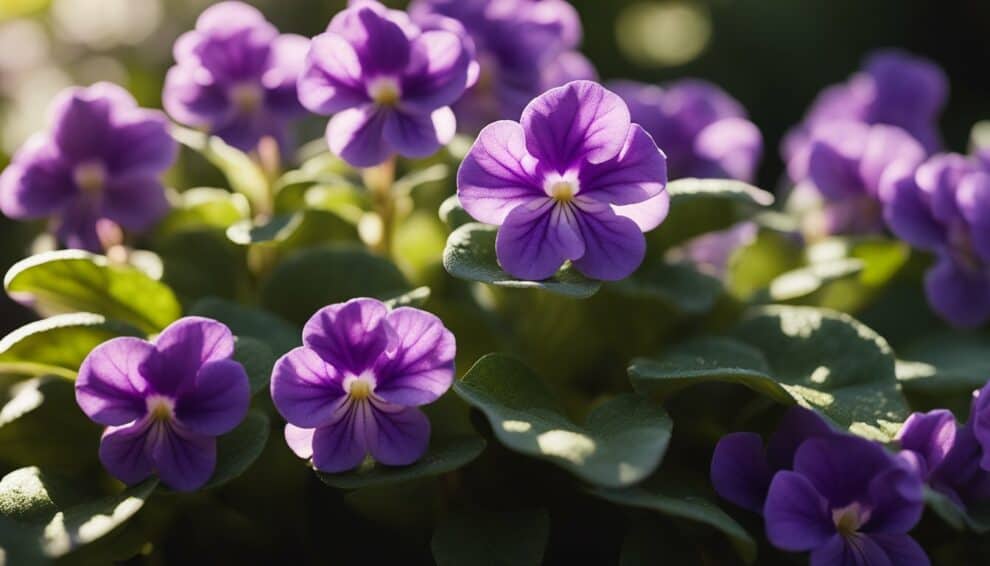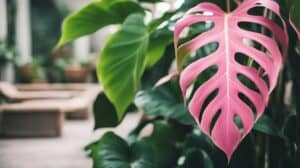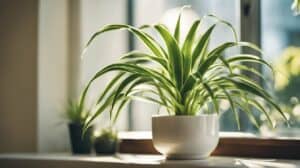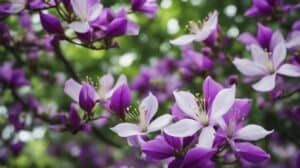African violets, also known as Saintpaulia, are delicate and beautiful plants that are popular among indoor gardeners.
These plants are native to Tanzania and Kenya, and they are named after Baron Walter von Saint Paul-Illaire, who discovered them in 1892.
African violets are easy to grow and care for, making them a great choice for those who are new to gardening.

One of the most interesting facts about African violets is that they come in a wide range of colors and patterns.
From solid shades of pink, purple, blue, and white to variegated patterns with stripes and spots, there is an African violet to suit every taste.
These plants also come in different sizes, from tiny miniatures to larger varieties that can grow up to 16 inches in diameter.
Another fascinating fact about African violets is that they are not true violets.
They belong to the Gesneriaceae family, which includes over 3,000 species of plants.
Despite their name, African violets are not related to the common garden violet, which belongs to the Viola genus.
However, African violets are just as beloved by gardeners and flower enthusiasts for their delicate, velvety blooms and easy care requirements.
Origins and History
Native Habitat
African violets, also known as Saintpaulia, are native to Tanzania and Kenya in East Africa.
They grow in the highlands at elevations of 4,000 to 6,000 feet, where the climate is warm and humid.
The natural habitat of African violets is under the shade of taller trees, where they receive filtered sunlight and protection from direct sunlight.
Discovery and Naming
African violets were discovered in 1892 by Baron Walter von Saint Paul-Illaire, a German colonial official in Tanzania.
He found the plants growing in the shade of a forest and sent some of them to his father in Germany.
The plants were then introduced to the horticultural world and became popular as houseplants.
The scientific name of African violets, Saintpaulia, was given in honor of Baron Saint Paul-Illaire.
The genus name, Saintpaulia, was first published in 1893 by H. Wendland, a German botanist.
The common name African violet was given due to the flower’s resemblance to violets, although they are not related to the true violets (Viola spp. ).
African violets have been cultivated for over a century and are now available in a wide variety of colors, sizes, and shapes.
They are a popular choice for indoor gardening due to their delicate beauty and ease of care.
Cultivation and Care

Lighting Requirements
African violets require bright, indirect light to thrive.
Direct sunlight can scorch their leaves, while low light can result in poor growth.
A north or east-facing window is ideal, but if a south or west-facing window is the only option, it’s best to use sheer curtains or blinds to filter the light.
Artificial lighting can also be used to supplement natural light.
Watering Techniques
Overwatering is a common mistake when it comes to African violets. They prefer to be kept slightly moist, but not wet.
Watering from the bottom is recommended, by placing the pot in a saucer of water and allowing the plant to absorb the water through the drainage holes.
It’s important to avoid getting water on the leaves, as this can cause spotting or rot.
Watering frequency will depend on factors such as the size of the pot, the type of soil, and the humidity level.
Soil and Fertilization
African violets require well-draining soil that is rich in organic matter.
A soil mix specifically designed for African violets is recommended, as it will have the appropriate pH and nutrient balance.
Fertilization is also important for healthy growth and blooming.
A balanced fertilizer with equal amounts of nitrogen, phosphorus, and potassium is recommended, applied every 2-4 weeks.
Propagation Methods
African violets can be propagated through leaf cuttings or division.
Leaf cuttings involve taking a healthy leaf and placing the stem end into moist soil or water until roots form.
Division involves separating offsets from the mother plant and potting them individually.
Both methods require patience and attention to detail, but can result in new plants that are genetically identical to the parent plant.
Varieties and Characteristics

Common Varieties
African violets come in a variety of colors, sizes, and shapes. Some of the most common varieties include:
- Standard: These are the most common African violets. They have a rosette of leaves and a single stem that produces flowers.
- Miniature: These are smaller than standard African violets, with leaves and flowers that are about half the size.
- Semi-miniature: These are slightly larger than miniature African violets, but still smaller than standard African violets.
- Trailer: These have a trailing habit and are often grown in hanging baskets.
- Variegated: These have leaves with white or yellow edges or centers.
Flower and Leaf Features
African violets are known for their delicate beauty, which is evident in their flowers and leaves.
Here are some of the flower and leaf features that make African violets so unique:
- Flower colors: African violets come in a wide range of colors, including pink, purple, blue, red, white, and bi-colored.
- Flower shapes: The flowers of African violets can be single, double, or semi-double, and can have ruffled or frilled edges.
- Leaf shapes: African violet leaves can be round, oval, or heart-shaped, and can be smooth or ruffled.
- Leaf colors: African violet leaves can be green, variegated, or have a reddish tint.
Overall, African violets are a beautiful and diverse group of plants that are sure to brighten up any room.
Health and Maintenance

Common Pests
African violets are prone to a few common pests, including spider mites, mealybugs, and thrips.
Spider mites are tiny and can be difficult to spot, but they can cause leaves to yellow and drop.
Mealybugs look like small, white, cottony masses and can be found on the undersides of leaves or in the soil.
Thrips are small, slender insects that feed on the leaves, causing them to have a silvery appearance.
To prevent infestations, keep the plant in a clean environment and inspect it regularly.
If an infestation is detected, isolate the plant and treat it with an insecticidal soap or oil.
Diseases and Prevention
African violets can be susceptible to several diseases, including root rot, crown rot, and leaf spot.
Root rot is caused by overwatering and can be prevented by allowing the soil to dry out slightly between waterings.
Crown rot is caused by a fungal infection and can be prevented by avoiding overwatering and ensuring good air circulation around the plant.
Leaf spot is caused by a bacterial or fungal infection and can be prevented by avoiding overhead watering and ensuring good air circulation.
If a disease is detected, remove any affected leaves or flowers and treat the plant with a fungicide or bactericide.
Pruning and Grooming
Pruning and grooming African violets can help to promote healthy growth and a bushy, attractive appearance.
Remove any dead or yellowing leaves as soon as they are noticed to prevent the spread of disease.
Pinch back the tips of the stems to encourage branching and promote the growth of new leaves and flowers.
Groom the plant by removing any spent flowers or flower stalks and wiping the leaves with a damp cloth to remove dust and debris.
Frequently Asked Questions

What are the best practices for caring for African violets indoors?
African violets are delicate plants that require special attention.
When caring for them indoors, it is essential to provide them with the right amount of light, water, and humidity.
They thrive in bright, indirect sunlight and prefer to be kept moist but not waterlogged.
It is best to water them from the bottom to avoid getting water on their leaves, which can cause damage.
Additionally, it is essential to keep them away from cold drafts and extreme temperatures.
How can I encourage my African violet to flower more frequently?
To encourage your African violet to flower more frequently, you should provide it with the right growing conditions.
They require a well-draining soil mix and prefer to be kept in a small pot.
It is also essential to fertilize them regularly with a high-quality African violet fertilizer.
Additionally, they require a consistent temperature and humidity level to thrive.
What are some interesting historical or cultural facts about African violets?
African violets were first discovered in Tanzania in the 1890s and were named after the German colonial official, Baron Walter von Saint Paul.
They became popular houseplants in the 1920s and have since become a favorite among plant enthusiasts.
In some cultures, African violets are believed to bring good luck and prosperity.
Why might African violet leaves turn yellow, and how can I prevent it?
Yellowing leaves on African violets can be caused by a variety of factors, including overwatering, underwatering, or exposure to extreme temperatures.
To prevent yellowing leaves, ensure that your plant is receiving the right amount of water and light.
Additionally, avoid placing them in drafty areas or near heating vents.
What are the ideal conditions for African violet pots and soil?
African violets prefer to be grown in small pots with a well-draining soil mix. The soil should be slightly acidic, with a pH between 6.0 and 6.5.
Additionally, it is essential to ensure that the pot has adequate drainage to prevent waterlogging.
How often should African violets be repotted, and what is the proper technique?
African violets should be repotted every 6-12 months or when their roots have outgrown their current pot.
When repotting, it is essential to use a well-draining soil mix and a pot that is slightly larger than the current one.
Gently remove the plant from its current pot, being careful not to damage the roots.
Remove any dead or damaged roots and place the plant in its new pot, filling in with soil around the roots.
Water the plant thoroughly and allow it to drain before returning it to its usual spot.














